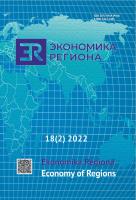Рост электропотребления российских регионов как фактор их социально-экономического развития
Electricity Consumption Growth in Russian Regions as a Factor of Their Socio-Economic Development
Author(s): Sergey A. NekrasovSubject(s): Economy, Geography, Regional studies, Labor relations
Published by: Институт экономики Уральского отделения Российской академии наук
Keywords: specific electricity consumption; structural stability of the economy; technocenosis theory; labour productivity;
Summary/Abstract: The indicator of specific (per capita) electricity consumption (SEC) is stabilising in developed countries and increasing in developing economies. At least since the mid-2000s, the difference between the two groups of countries in terms of available power has been decreasing. In contrast to this trend, the transition of Russia to a market economy is characterised by the divergence of regions in terms of SEC. SEC of regions, being on average similar to that of the Netherlands, France, Germany, Great Britain, began to differ by 20 times. The technocenosis theory shows the need to change this negative trend. The low electricity consumption of developing countries depends on their inability to increase its production. In Russia, the problem is due to the low potential of the consumption sector, primarily in regions with SEC below 4 MWh/person per year. The solution of this macroeconomic problem, namely, the reduction of the existing differentiation in regional specific electricity consumption will help maintain the structural stability of the Russian economy and ensure its functioning in the context of external environment changes. Creation of conditions for the energy consumption development in industrial and agricultural enterprises is not a sectoral task of the electric power industry. Considering the sanctions imposed on Russia, structural stability of the national economy can be increased by improving the investment climate resulting from a decline in electricity prices for new non-residential consumers in regions with SEC below the level of developing countries. For these subsidy depending “outsider” regions, an increase in the availability of electricity, rather than the construction of new energy facilities, stimulates the labour productivity growth, re-industrialisation, and emergence of growth points.
Journal: Экономика региона
- Issue Year: 18/2022
- Issue No: 2
- Page Range: 509-527
- Page Count: 19
- Language: Russian

